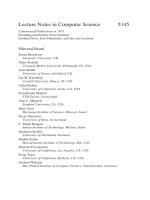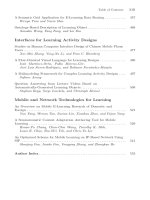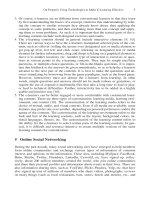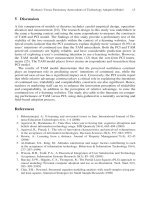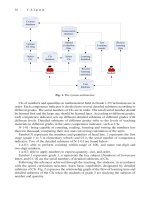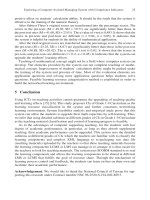Lecture Notes in Computer Science- P14 pps
Bạn đang xem bản rút gọn của tài liệu. Xem và tải ngay bản đầy đủ của tài liệu tại đây (148.03 KB, 5 trang )
Research on Learning Resources Organization Model 55
3.2.4 Learning Content Scheduling Algorithm
The scheduling algorithm of learning contents explains how to choose a appropriate
learning object when the learner begins to learn a knowledge cluster. At first, it de-
termines the knowledge point according to the sequence relations of knowledge, and
then chooses the best learning object according to the learner’s learning style and the
learning context. The organization of learning contents mainly includes two aspects.
One is how to show the appropriate learning contents after choosing the knowledge
cluster to learn, the other is how to diagnose difficult knowledge points and choose
the appropriate learning content when the learner ends the learning and does not pass
the test. Fig 5 shows the relation of knowledge points sequence relations and person-
alized manifestation.
Fig. 5. The relation of knowledge points sequence relations
When the learner begins to learn a new knowledge cluster, the system runs the
scheduling algorithm as follows.
(1) The learner chooses a knowledge cluster according to his needs.
(2) The system provide the learner with pre-test according to his learning state and
the selected knowledge cluster, in order to test whether the learner has the ability to
learn the knowledge cluster.
(3) Providing the learner with the best appropriate knowledge point on the basic of
knowledge points’ sequence relations. Choosing knowledge points is the strategy of
presenting the learning object according to the learner’s learning style, personalized
characteristic, etc.
(4) Providing the learner with the appropriate learning object from the same
knowledge.
(5) Repeating (3), (4) , and providing all the knowledge points in the knowledge
cluster to the learner step by step.
When the learner finishes the learning of a knowledge cluster, but he does not pass
the test, the system will find the difficult knowledge point, and then choose the ap-
propriate learning object of the knowledge point according to the learner’s personal-
ized characteristic.
56 Q. Liu and Z. Sun
3.3 Post-test and Evaluation
The result of examination may be changed with different environment or psychologi-
cal condition, so it is inaccurate to judge his master degree depending on the result of
examination. Therefore, we should consider the examination result, and also we
should consider the learner’s learning activity, such as participating in discussion,
answering the questions and so on during the evaluation, teachers can evaluate the
learner according to the information of his learning activity. The system can get the
final result by considering the examination and the teachers’ evaluation and provide
the grade to the learner.
4 Application of Learning Resources Organization Model
We implement our algorithm in our system named E-learning Service Platform
(ELSP), which has been developed with J2EE. ELSP is a complex e-learning system
included learning management system, content management system, testing system
and so on. According to the content organization algorithm, the related databases
include information of the learner, attributes of knowledge, attributes of knowledge
cluster and learning state and style and so on. In which, the learner’s information is
comprised of name, sex, birthday, password, ID, telephone and email etc. Knowledge
point attributes include name, up-node, sub-node, cognitive rank, etc. The learning
state and style includes name, learned knowledge cluster, ability level, style, attempt
times, test time, difficult knowledge point and the progress of learning and so on. At
same time, we design e-learning courseware named “database theory and technology”
with a lot of learning objects. The courseware is used for college students in Educa-
tion Technology in Central China Normal University. The knowledge tree is pre-
sented in Fig 6 based on database.
Fig. 6. The dynamic knowledge tree
The following information in fig7 shows the learner’s progress, the level of learned
knowledge cluster, attempt times and learning time. It reflects the learning situation
dynamically.
Research on Learning Resources Organization Model 57
Name Learned
Knowledge
Cluster
Mastering
Level
Trying
times
Testing
time
Difficult
knowledge
point
Next
Knowledge
point
Zhang min Requirement
analysis
Better 1 2006-3-20 Null Design of
concept.
Wang fang Design of
concept.
Bad 1 2006-4-20 View
integration
Logical
structure
Li hai Design of
concept.
Good 3 2006-4-19 Null Logic
structure
Liu ruibing Logical
structure
Good 1 2006-4-26 View
integration
Physical
design.
…… …… …… …
…
…… …… ……
Fig. 7. Organization and schedule of learning resources
Compared to Simple Sequence Specification, Learning Design Specification, our
designed algorithm focuses on the organization and schedule of learning resources
according to different learners and learning situation. It mainly has the following
merits:
(1) It can dynamic construct the learning content, and provide different content to
learners, which met the personalized needs better.
(2) The resources described with e-learning technology standards can realize the
resource to be reused and shared.
(3) During the learning process, the algorithm is checking learning situation and
learners’ state to schedule learning resources, so its performance is better, its effi-
ciency is higher.
5 Conclusions
The paper constructs the learning resources framework model, defines granularity of
the learning object, designs the learning content scheduling algorithm, which includes
pre-test, knowledge points learning, post-test and evaluation. The paper put forward
the learning content scheduling algorithm from knowledge sequencing and personal-
ized representation as two dimensions. the following work mainly includes: (1) the
learning activities as an important origin of the testing data, needs the further design-
ing and developing. (2) how to obtain the information of learner’s personalized char-
acteristic needs to have further research. (3) the algorithm of personalized presenting
the learning object needs to perfect.
Acknowledgments. The paper is supported by Specialized Research Fund for the
Doctoral Program of Higher Education, Ministry of Education of China
(NO20050511002), supported by the Programme of Introducing Talents of Discipline
to Universities
Ministry of Education and State Administration of Foreign Experts
Affairs of China (NOB07042), Supported by NSFC of China(NO60673094) , partly
supported by the Natural Science Foundation of Hubei Province(NO.2006ABC011)
58 Q. Liu and Z. Sun
and by National Great Project of Scientific and Technical Supporting Programs
Funded by Ministry of Science & Technology of China During the 11th Five-year
Plan (NO. 2006BAH02A24).
References
1. Wiley, D.A., et al.: The Instructional Use of Learning Objects,
(2001)
2. Abruf: IEEE Learning Technology Standards Committee (LTSC) Learning Object Meta-
data - Draft Document v6. 0 (2001),
3. IMS Simple Sequencing Best Practice and Implementation Guide (2006), http://www.
imsglobal.org/simplesequencing/ssv1p0/imsss_bestv1p0.html
4. IMS Global Learning Consortium: Learning Design Specification (2007), http://www.
imsglobal.org/learningdesign/
5. The SCORM Overview, SCORM version 1.2.,
ADLDOCS/Doeuments/SCORM-1.2-Overview.pdf
6. Issack Santally, M.: A Learning Object Approach to Personalized Web-based Instruction.
European Journal of Open Distance and E-learning (EURODL)
7. Furugori, N., et al.: COALE: Collaborative and Adaptive Learning Environment (2007),
8. lu, W., hui, Y., le, D.: Research on knowledge representation and illation based on fuzzy
relation data model of ITS. Journal of E-education Research 4, 30–34 (2005)
9. Xiaoyong, H., Zhiting, Z.: The taxonomy of reused learning objects. Journal of E-
education Research 8, 10–15 (2003)
10. Steinacker, A., Seeberg, C., Reichenberger, K., Fischer, K., Steinmetz, R.: Dynamically
Generated Tables of Contents as Guided Tours in Adaptive Hypermedia Systems. In: Pro-
ceedings of the EdMedia & EdTelecom (1999)
11. Fischer, S., Steinmetz, R.: Automatic Creation of Exercises in Adaptive Hypermedia
Learning Systems. In: Proceedings of 10th ACM conference on Hypertext (HT 2000) (to
appear, 2000)
12. Cisco: Reusable Learning Object Strategy, n/warp/
public/10/wwtraining/elearning/imple-ment/rlo-stratrgy.pdf
F. Li et al. (Eds.): ICWL 2008, LNCS 5145, pp. 59–68, 2008.
© Springer-Verlag Berlin Heidelberg 2008
Web Contents Extracting for Web-Based Learning
Jiangtao Qiu
1, 2
, Changjie Tang
2
, Kaikuo Xu
2
, and Qian Luo
2
1
School of Economic Information Engineering, South Western University of Finance and
Economics, Chengdu, China 610074
2
Computer School, Sichuan University, Chengdu, China 610065
Abstract. Web mining has been applied to improve web-based learning. Con-
tent-based Web mining usually focuses on main contents of web page. This paper
proposes a novel approach to automatically extract main contents from web
pages. Compared with existed studies, the method may determine whether a web
page contains main contents, and then extracts main contents without using
DOM-Tree and template. Main contributions include: (1) Introducing a new
concept of Block and proposing a method to partition web page to blocks. Main
contents and noise contents may be well partitioned into different blocks. (2)
Introducing a concept of Web Page Block Distribution and studying its feature.
Based on Block Distribution, we may effectively determine whether the web
page contain main contents, and then extract main contents via outlier analysis.
Experiments demonstrate utility and feasibility of the method.
Keywords: Web-Based Learning, Web Contents Extracting, Web Mining.
1 Introduction
Web mining has been applied to improve web-based learning. Content-based Web
mining usually focuses on main contents of web page, and regards advertisements,
navigation sidebar and copyright notice, etc as noise. Noise has a negative impact on
analysis of web contents, for example, reducing accuracy of web classification and
clustering. Some studies [1, 2] analyzed how noises harm web mining.
In Content-based web mining, usually, it needs to collect web pages, and then de-
termine whether web pages include main contents. We refer having main content page
and not having main content page to content page and non-content page respectively.
We need to extract main contents from content pages. The existed methods have some
limits on applications: (a) all web pages are assumed to be content pages. This as-
sumption, however, is indefensible in application. In most cases, the collected web
pages are mixture of content pages and non-content pages. (b) template-based methods
assume that web pages coming from same web site have same layout. Hence they may
correctly extract contents from web pages matching with template. To get correct
contents from all web pages, however, it is necessary to build templates for all involved
website. This is a very arduous work. (c) DOM-Tree-based method firstly converts a
piece of web pages to a Dom-Tree, then extract contents from the DOM-Tree. Refer to
our naive purpose that get main contents from web pages, Dom-Tree, with complicated
structure and rich functions, is obviously cost-expensive.
